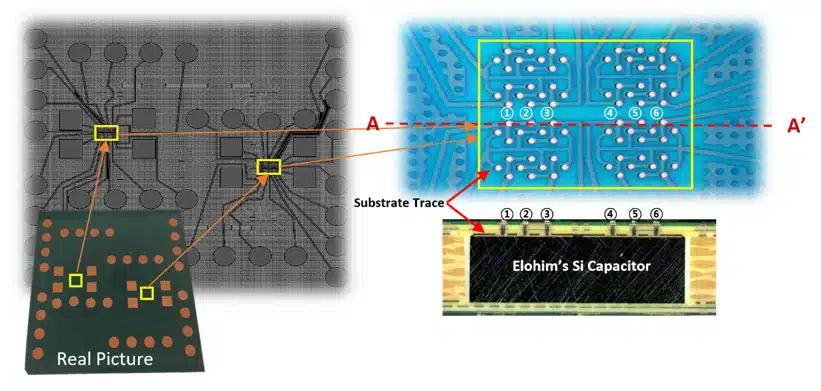Elohim Inc., a leading innovator in embedded silicon capacitor technology, proudly announces a transformative collaboration with Daeduck Electronics, an esteemed player in the semiconductor packaging industry.
The latest development sees Elohim’s silicon capacitors embedded within Daeduck’s cutting-edge FCBGA substrate product, setting the stage for groundbreaking applications and future advancements.
Daeduck Electronics conducted thorough reliability verification of Elohim’s silicon capacitors integrated into their component embedded substrate. Remarkably, the capacitance characteristics exhibited no significant change before and after reliability tests under thermal and highly accelerated stress tests. This reinforces the stability and resilience of Elohim’s silicon capacitor technology under varied environmental conditions.
Building on this successful integration, Elohim Inc. and Daeduck Electronics are set to enter the commercialization phase, with a focus on advancing semiconductor packaging solutions. The strategic collaboration aims to refine the integration of Elohim’s silicon capacitors into the FCBGA substrate, providing the semiconductor industry with a state-of-the-art packaging solution that meets the evolving demands of electronic devices.
The successful integration and evaluation open new doors for applications of Elohim’s silicon capacitors within the semiconductor industry. The Si-capacitor embedded FCBGA substrate, now validated for reliability, is expected to play a pivotal role in applications ranging from data centers to mobile application processors, GPU and CPU packages, and beyond. Elohim Inc. and Daeduck Electronics foresee a transformative impact on power optimization, reliability, and performance in electronic devices.
In a strategic move towards commercialization, Elohim Inc. and Daeduck Electronics are actively advancing their joint development with the aim of introducing a target product to the market. The companies are committed to refining the integration process, ensuring the seamless incorporation of silicon capacitors into the RDL interposer for widespread application in various electronic devices. The collaborative effort is poised to achieve commercialization by the end of 2024 or early 2025, setting ambitious targets for the semiconductor packaging industry.
The collaboration between Elohim Inc. and Daeduck Electronics signifies a strategic partnership dedicated to achieving technological excellence in the semiconductor packaging sector. By surpassing reliability tests and setting ambitious commercialization goals, the companies reinforce their commitment to pushing the boundaries of innovation in electronic components.
About Elohim Silicon Capacitors
ELOHIM ultra-high-density silicon capacitors have been developed with high-k dielectrics and low-resistivity electrodes using semiconductor processes, employing a deep trench 3D structure to achieve a smaller size and higher capacitance. ELOHIM’s technology offers a range of form factors, providing high capacitance levels up to 1,000 nF/mm² (with 2,000 nF/mm² under development).
Currently, products with a silicon thickness of 70 μm are in the production stage (50 μm available on request). Reliable dielectric and electrode performance, as well as capacitance and electrical characteristics, are optimized through silicon processes. Customizable multi-terminals contribute to the high performance (low ESR and low ESL) of the silicon capacitor in various designs. ELOHIM silicon capacitors feature stability in the face of temperature and voltage changes, ensuring reliability over a 10-year lifespan (TDDB).
Features of Elohim 1st Generation Si Capacitor (Deep Trench)
- >1,000 nF/mm² capacitance Density
- >5 V Breakdown Voltage for Mobile and HPC
- -65°C ~ 150°C Operation Temperature range
- Size: 0.6×1.0mm, 1.2×1.0mm, 1.8×1.6mm, 2.6×2.1mm in thickness 70-635um
- Capacitance Range: 250nF – 4600nF
- Use for power delivery
| Items | Target | Achieved |
|---|---|---|
| Equivalent Series Resistance (ESR) | < 30 mΩ | 2 mΩ |
| Equivalent Series Inductance (ESL) | < 30 pH | 0.56 pH |
| Voltage Coefficient of Capacitance (VCC) | < 1.0 %/V | 0.6 %/V |
| Temperature Coefficient of Capacitance (TCC) | < 1.0 %/°C | 0.032 %/°C |
| Breakdown Voltage | > 5 V | 5.3 V |

































